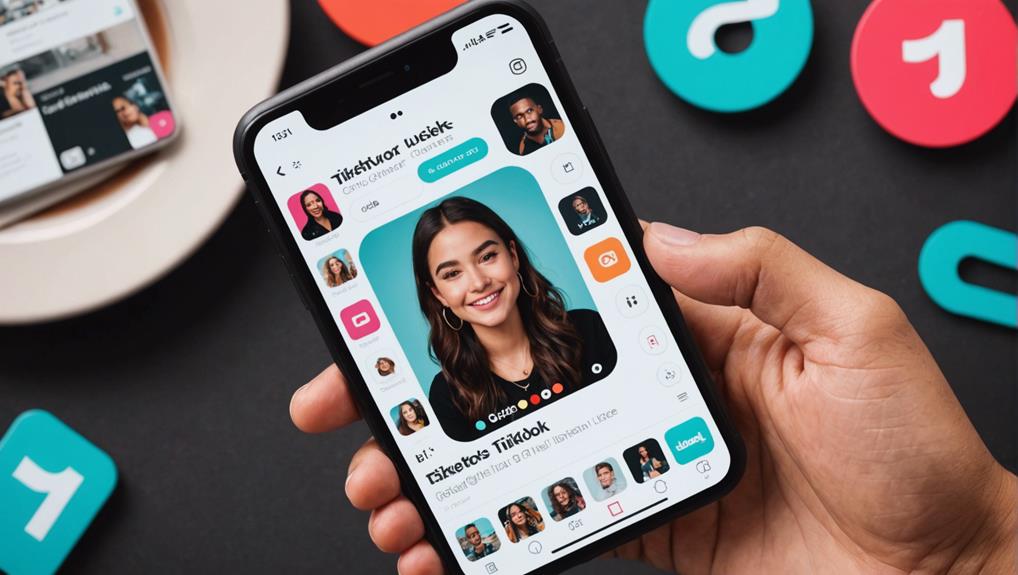Mastering TikTok influencer partnerships involves leveraging its dynamic platform with over 1.5 billion users and an average engagement rate of 2.67%. Brands should strategically choose influencers by aligning audience demographics with their target market, focusing on engagement over follower count. Effective communication and well-crafted pitches facilitate successful collaborations. Setting clear, SMART campaign goals guarantees precise outcomes, while ongoing performance monitoring and qualitative feedback strengthens partnerships. Budget planning must account for influencer fees and production costs. Through careful selection and strategic planning, brands can maximize TikTok’s potential. Discover how these elements interconnect to drive influencer marketing success.
Key Takeaways
- Align influencer audience demographics with your target market using TikTok analytics for effective engagement.
- Prioritize engaging influencers with authentic content that aligns with your brand values.
- Develop SMART campaign goals and define KPIs to measure influencer partnership success effectively.
- Communicate directly with influencers, offering concise pitches highlighting collaboration benefits.
- Ensure compliance with FTC guidelines by requiring clear disclosure of paid partnerships in influencer posts.
Understanding TikTok’s Influence
TikTok’s influence in the digital landscape is undeniable, with its rapid ascent to over 1.5 billion users globally positioning it as a powerhouse in social media engagement. This platform’s unique algorithm fosters high engagement rates, averaging 2.67%, surpassing traditional platforms like Instagram. Such metrics are pivotal for TikTok influencers who drive brand awareness and cultivate a dedicated audience.
The platform’s ability to sustain an average user engagement of over 49 hours per month signifies its deep content consumption, which brands can leverage through strategic influencer marketing campaigns.
The loyalty of approximately 90% of TikTok users to brands highlights the platform’s potential for building long-term consumer relationships. This loyalty, coupled with 52% of users expressing interest in shopping through TikTok, underscores its impact on consumer behavior and the effectiveness of authentic content in influencer marketing efforts.
TikTok’s extensive library of sounds and effects not only enhances creative expression but also allows brands to engage audiences in innovative ways, ensuring campaigns resonate effectively.
As brands navigate the evolving digital landscape, understanding TikTok’s influence is essential for executing impactful marketing strategies that align with contemporary consumer trends.
Types of TikTok Collaborators
Harnessing the potential of TikTok’s influential landscape requires a strategic approach to collaborations, as different types of TikTok collaborators play unique roles in marketing strategies.
These collaborators can be categorized into three main types: affiliates, creators, and influencers. Each group contributes distinct types of content and impacts brand engagement in diverse ways, aligning with specific brand values.
Affiliates specialize in user-generated content (UGC) that is directly linked to sales through TikTok Shop. Operating under commission-based models, they effectively convert content into tangible sales, making them essential for performance-driven campaigns.
TikTok creators, on the other hand, focus on crafting bespoke content tailored for a brand’s channel. By charging for their creative expertise, they fortify brand visibility and engagement, positioning themselves as key players on the influencer marketing platform.
Influencers leverage their personal channels to disseminate brand messages to an established audience. Their ability to cultivate higher engagement rates and conversions can be particularly advantageous for brands seeking to enhance their market presence.
However, partnerships with influencers often entail higher costs, given their extensive reach and engagement prowess. Understanding these dynamics is significant for brands aiming to align their marketing objectives with the right type of TikTok collaborator.
Selecting the Right Influencers
When starting on TikTok influencer partnerships, understanding the intricacies of selection is vital to campaign success. Selecting the right influencers involves aligning their audience demographics with your target market. Utilize TikTok analytics to explore insights regarding followers’ age, gender, and location. This data-driven approach guarantees that the chosen influencers can effectively reach your desired audience.
Moreover, prioritize engagement metrics over sheer follower count. TikTok influencers boast an engagement rate of up to 2.67%, surpassing other platforms like Instagram. High engagement indicates an active audience more likely to interact with your content, amplifying campaign goals.
Authentic partnerships are also essential; select influencers who consistently create content that resonates with their followers and aligns with your brand values. Consider influencers with a proven track record of collaborations, as they often exhibit higher trust and commitment. This history can lead to more successful and seamless campaigns.
To streamline the selection process, leverage influencer marketing platforms like Kolsquare. These platforms utilize AI to match brands with influencers based on campaign goals and expertise.
- Align audience demographics with target market
- Focus on engagement metrics over follower count
- Guarantee authentic partnerships reflecting brand values
- Choose influencers with a successful collaboration history
- Use influencer marketing platforms for efficient selection
Crafting Effective Communication
Effective communication is the cornerstone of successful TikTok influencer partnerships, driving engagement and guaranteeing alignment with campaign objectives. Direct communication with influencers not only enhances brand engagement but also fosters a mutual understanding of the TikTok influencer marketing campaign’s goals.
By integrating audience insights and relevant case studies into pitch decks, brands can effectively capture influencers’ attention, demonstrating the potential value and impact of collaboration. This data-driven approach aligns influencer efforts with campaign objectives, leading to a more successful campaign outcome.
Proposals should be rich with detailed information about the brand and campaign goals to increase influencer interest and commitment. Influencers seek clarity and purpose, and a well-crafted proposal can greatly influence their decision to collaborate.
Furthermore, clear contact details in social media bios streamline outreach efforts, enabling seamless initial communication and connection with potential influencers.
Concise and focused pitches that underscore the benefits of collaboration resonate more effectively with influencers, resulting in successful negotiations and partnerships. Highlighting the advantages of working together guarantees influencers appreciate the value they bring to the campaign.
Through effective communication, brands can build a strong foundation for a successful TikTok influencer marketing campaign, fostering meaningful and productive partnerships.
Building Long-Term Collaborations
Fostering long-term collaborations with TikTok influencers strategically enhances brand trust and loyalty, as repeated interactions encourage sustained conversations within the influencer’s community.
These partnerships are a cornerstone of successful influencer marketing, as they enable brands to cultivate authentic content that resonates deeply with audiences. Engaging influencers over extended periods allows brands to leverage creative approaches, such as organizing brand ambassador weekends or exclusive events, which can greatly strengthen the emotional bond between the influencer and the brand.
To maximize the benefits of long-term collaborations, brands should consider these key strategies:
- Authenticity: Encourage influencers to create genuine content that aligns with their personal style and the brand’s ethos.
- Cost Efficiency: Long-term partnerships often result in reduced costs, with better rates for extended collaboration deals.
- Creative Integration: Utilize innovative event-based strategies to enhance emotional connections and content engagement.
- Audience Insights: Regularly assess audience feedback to refine strategies and maintain relevance.
- Performance Monitoring: Conduct qualitative assessments of content integration to measure collaboration success.
These strategies not only guarantee effective influencer marketing but also contribute to a sustainable and mutually beneficial relationship between brands and influencers, ultimately fostering enduring brand trust.
Setting Clear Campaign Goals
Building long-term collaborations with TikTok influencers can considerably enhance brand loyalty, yet the foundation of these partnerships lies in setting clear and strategic campaign goals. Establishing SMART goals—specific, measurable, achievable, relevant, and time-bound—provides the necessary direction for influencer campaigns to align with overarching brand objectives.
This strategic alignment guarantees that each campaign phase, whether focused on brand awareness, engagement, or conversion, maximizes both impact and effectiveness.
Defining key performance indicators (KPIs) is vital to evaluating the success of these influencer campaigns. Metrics such as engagement rates, reach, and conversion rates are pivotal in determining whether the set objectives are being met. By tailoring campaign goals to different stages of the marketing funnel, brands can optimize these partnerships to achieve desired outcomes.
Utilizing audience insights and analytics from TikTok is essential for refining campaign goals. Understanding TikTok users’ preferences allows brands to create content that resonates with target demographics and aligns with user interests.
Regularly reviewing and adjusting campaign goals based on performance data and feedback further optimizes influencer strategies. This approach not only enhances overall campaign results but also fortifies the effectiveness of influencer partnerships in resonating with the ever-evolving audience landscape.
Analyzing Audience Demographics
In mastering TikTok influencer partnerships, a thorough understanding of audience composition is essential, as it allows brands to tailor messages that resonate with diverse age groups, particularly the rapidly growing 18-24 demographic.
By analyzing demographic trends, such as gender distribution and geographic location, brands can craft targeted campaigns that align with the preferences of specific user segments.
Leveraging TikTok’s robust analytics tools further enables brands to gain insights into audience interests and behaviors, optimizing influencer collaborations to align with trending topics and maximize engagement.
Understanding Audience Composition
Analyzing audience demographics is a foundation of successful TikTok influencer partnerships, enabling brands to craft data-driven strategies that resonate with their target market. By leveraging insights from TikTok’s analytics tools, brands can explore the intricate details of their audience composition, including key factors such as age, gender, location, and behaviors.
This thorough understanding allows for more effective content creation and influencer selection, aligning campaigns with the diverse user base that TikTok boasts—over 15 million in the UK alone.
Understanding these demographics is essential because TikTok’s audience has evolved from mainly younger users to a more inclusive age range. Brands that identify these shifts can better tailor their marketing efforts, enhancing engagement and campaign effectiveness.
Here are some considerations for evaluating audience demographics:
- Age Distribution: Targeting content appropriate for different age groups.
- Gender Insights: Crafting messages that appeal to specific gender segments.
- Geographical Targeting: Customizing campaigns for geographic locations.
- Behavior Patterns: Understanding user interaction with content.
- Interest Alignment: Matching influencer content with audience interests.
Moving from guesswork to informed decision-making, demographic analysis informs strategic partnerships with influencers, ensuring content resonates with the intended target audience.
Analyzing Demographic Trends
Harnessing the power of demographic trends on TikTok provides brands with a strategic advantage in influencer partnerships. Analyzing TikTok’s audience reveals that over 40% of the platform’s global user base is aged 16 to 24, highlighting the significance of engaging content that resonates with Gen Z. However, the platform’s growing appeal is evident among users aged 25 to 34, signaling an opportunity for brands to tap into a broader demographic.
Understanding TikTok’s gender composition is essential, with approximately 60% of users being female. Brands should craft their messaging to appeal to this majority while guaranteeing inclusivity for the 40% male audience. Geographic insights further emphasize TikTok’s strong presence in key markets, such as the United States, China, and India, which brands must consider when developing regional content strategies.
| Age Group | Percentage of Users |
|---|---|
| 16-24 | Over 40% |
| 25-34 | Increasing |
| Gender Split | 60% Female, 40% Male |
To maximize engagement, brands should align their content with popular TikTok categories like dance challenges, humor, and lifestyle. Collaborating with relevant influencers guarantees brands connect authentically with their target audience, leveraging demographic insights to optimize their strategies effectively.
Leveraging TikTok Insights
A wealth of insights can be gleaned from TikTok’s robust analytics tools, providing brands with a precise understanding of audience demographics. With over 15 million users in the UK and a strong Gen Z presence, TikTok offers a fertile ground for brands targeting younger audiences.
These analytics tools enable brands to dissect audience demographics such as age, gender, and location, crafting content that resonates with specific segments and drives engagement.
Key benefits of leveraging TikTok audience insights include:
- Enhanced Targeting: Tailor marketing campaigns to align with the audience’s preferences, ensuring more effective communication.
- Influencer Alignment: Choose influencers who naturally engage with the target demographic, enhancing authenticity and relatability.
- Content Optimization: Identify trending topics and content styles that capture the audience’s interest, ensuring relevance.
- Increased Engagement: Harness insights to develop content strategies that maintain high user engagement, reflected by the average 49 hours spent on the app monthly.
- Strategic Growth: Use demographic data to expand brand reach efficiently within desired markets.
Brands that integrate TikTok insights into their influencer partnerships can craft marketing campaigns that not only captivate but also convert, leveraging the platform’s high engagement levels to achieve strategic objectives.
Budgeting for Influencer Campaigns
Maneuvering the financial landscape of TikTok influencer campaigns requires a strategic approach to budgeting that accounts for various cost components. A brand must meticulously assess influencer fees, which can vary greatly based on follower count and engagement rates, typically ranging from $100 to $10,000 per post.
This variability necessitates a thorough budgeting plan that includes not only these fees but also production costs, promotional expenses, and the anticipated campaign duration. By understanding market standards for influencer rates, brands can gain leverage in negotiations, allowing them to reference average costs in their niche effectively.
To maximize the value of these partnerships, consider potential discounts for long-term collaborations. Many influencers are amenable to negotiating rates for ongoing partnerships, which can be beneficial for both parties.
Transparency about budget constraints during initial discussions can foster trust and facilitate more effective negotiations. This openness often leads to mutually beneficial outcomes, aligning expectations and financial capabilities.
Additionally, brands should explore package deals that might offer additional savings. By strategically approaching budgeting and negotiations in TikTok influencer campaigns, brands can guarantee a well-rounded financial plan that supports successful and sustainable influencer partnerships.
Frequently Asked Questions
How to Collaborate With an Influencer on Tiktok?
To effectively collaborate with a TikTok influencer, start by identifying influencers whose audience aligns with your campaign goals. Develop a content strategy emphasizing authenticity. Use performance metrics for assessment, fostering long-term relationships based on data-driven insights.
How Do You Get Partnerships on Tiktok?
To secure partnerships on TikTok, utilize TikTok growth strategies and influencer outreach techniques, ensuring brand alignment through content creation ideas. Employ engagement boosting methods and audience analysis tools for effective collaboration, enhancing campaign success and broader reach.
How Much Do You Get Paid for Paid Partnerships on Tiktok?
TikTok influencer payment rates vary based on audience engagement, content quality, and brand alignment. Influencers earn between $200 and $20,000 per post, influenced by platform algorithms, niche markets, and their ability to meet specific campaign goals.
How to Promote Influencer Content on Tiktok?
To effectively promote influencer content on TikTok, brands should develop a content strategy focusing on audience engagement through creative storytelling and brand alignment, while leveraging trend analysis and performance metrics to maximize visibility and refine promotional efforts.
Conclusion
In summary, mastering TikTok influencer partnerships necessitates a strategic approach that involves understanding the platform’s influence, selecting the appropriate types of collaborators, and crafting effective communication. Establishing long-term collaborations, setting clear campaign goals, and analyzing audience demographics are essential for maximizing impact. Additionally, budgeting effectively for influencer campaigns guarantees resource optimization. By leveraging data-driven insights and staying attuned to evolving trends, brands can enhance their engagement and achieve substantial success in this dynamic digital landscape.




